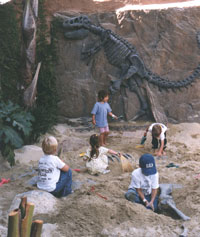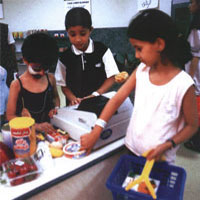
Vol. III, No. 1, January 2003
- From the Editor
- Who Goes to Entertainment Venues with Children & Which are Tons of Fun?
- Announcing LOBEX
- Mark Your Calendar for Foundations!
- PBS KIDS Announces Edutainment Destinations
- Best Customers Overlooked
- Evolution of Family Lifestyle Center
- Americans Not on the Move
- Spotlight on Edutainment, Part 2, Children' Edutainment
- Coming in Next Month' Issue
Spotlight on Edutainment, Part 2, Children' Edutainment
In last month's issue, we discussed what edutainment is, its history and its increasing popularity. This month we will discuss a unique, powerful, and usually misunderstood form of edutainment, children's edutainment.
What we call children's edutainment is really just children's play. To adults, play is just fun, it's relaxing and recreational, not work. Many adults view children's play as nothing more than mindless play with little value. Nothing could be further from the truth.
For adults, edutainment falls somewhere in the middle of the education-entertainment continuum, it has a little of both. For children up to about age 8, play is a very unique form of edutainment since it is both 100% education and 100% entertainment. Children are biologically wired to play. It is nature's way of programming them with a pleasurable activity that teaches them about the world around them and how to become part of society. Play is child's work. Play to children is unlike play to adults.
 Decades
of research in child development and recent research in brain development
has substantiated the crucial role play has in children's optimal cognitive,
physical, emotional and social development. It is their primary mode of learning.
It is their most effective way of learning. Children's play that is age, developmentally
and culturally appropriate is called developmentally appropriate play.
Decades
of research in child development and recent research in brain development
has substantiated the crucial role play has in children's optimal cognitive,
physical, emotional and social development. It is their primary mode of learning.
It is their most effective way of learning. Children's play that is age, developmentally
and culturally appropriate is called developmentally appropriate play.
In academic terms, developmentally appropriate play is free-choice learning--learning that is guided by a person's interests and motivations, and which involves considerable choice on the part of the learner as to when, where, why and what to learn. Developmentally appropriate play has these characteristics:
- Highly pleasurable
- Process oriented, non-goal directed. The outcome is not as important as the process.
- Child-initiated and self-directed
- An activity of the mind, imaginative
- Free of imposed tasks or adult imposed rules
- Hands-on/participatory
- Open-ended
One of the unique qualities of play is that it has high repeat appeal. This is due to the fact that children create their own play scripts, and the scripts constantly change, so the play is different every time. As I often explain, I grew up in a sandbox in my backyard. Everyday, weather permitting, I spent hours playing in the sandbox. I was never bored. In adult terms, it was like going to the same movie theatre everyday, but with a new movie playing. Children's play is powered by their imaginations; they are their own scriptwriters, movie producers, directors and actors, all at the same time with constantly changing stories.
This biologically programmed repeat appeal is what makes children's edutainment so powerful an attraction for located-based entertainment venues. By calling it edutainment rather than just play, parents perceive it as nourishing to their children (which it is) with a higher value than just amusements or entertainment. For the children, it's just fun.
Children's edutainment has a number of applications in location-based venues. It can be an attraction itself in the form of indoor children's edutainment centers, outdoor adventure play gardens or a combination of both. It can be part of larger family entertainment facilities. We have designed small children's edutainment areas adjoining food courts in malls and as parts of community recreation and fitness/health centers. It can be farm-based, such as at a children's discovery farm, when it is sometimes called agritainment. The Brookfield Zoo has created a children's edutainment area called Play Zoo that incorporates animals and developmentally appropriate play. Many botanical gardens have created children's gardens based upon edutainment principals. We are even working with a church on a Christian children's edutainment project.
Part of the secret of creating successful children's edutainment experiences is the design of the events and the environment. Children's edutainment is a lot different than other types of entertainment where you can go to Fun Expo, IAAPA or pick up a catalog and order equipment. Children's edutainment events are almost all totally custom designed. It's not like a ride that you can add to a space. In fact the design of the space, the environment, is as critical to the success of edutainment as the event itself.
Edutainment needs to be designed from an understanding of child development and approached "through the eyes of the child," with sensitivity to a child's scale and how they see, interpret and use space and objects. Since much of children's play takes place in their minds through imagination, you need to create the right space (the stage) and supply the right objects (the props) to support their play (act out their scripts). Since children's physical size, skills and play changes as they develop, the edutainment needs to offer a continuum of challenge, so children's size, interests and abilities will match the play opportunities. Edutainment requires a match between their development and capabilities and the play opportunities. If there is a mismatch with what children have the interest and ability to do, they will be bored.
The design of the space or environment will actually shape children's behavior.
Children read environments differently than adults. To them it is not background,
 but
rather something to interact with. Design a long straight hallway and children
will instinctively run down it. They are not misbehaving. They are doing exactly
what the environment "told" them to do.
but
rather something to interact with. Design a long straight hallway and children
will instinctively run down it. They are not misbehaving. They are doing exactly
what the environment "told" them to do.
Even the difference of a few inches can affect children's behavior. Several years ago we designed our first pretend fishing event for a children's edutainment center in the Middle East. It was designed so children could fish from a scaled-down model of a dhow, a traditional teak boat found in the Persian Gulf. We visited the center after it opened for post-opening evaluations. Children were climbing over the sides of the boat, climbing into the stream and jumping off the bow. These of course were not desirable behaviors. Our Education & Child Development Director observed the problem for some time before she concluded the boat wasn't built to our dimensions. We checked and the sides of the boat were 3" lower than we had specified. We made the contractor aware of the problem and the sides of the boat were modified to the correct specifications. On a return trip we observed that there were no longer any behavior problems associated with the pretend fishing. The difference of just a few inches can dramatically change children's behavior and play.
We've seen the same issues with blocks. Children love to play with blocks. However, both the size and type blocks and the design of the environment where the block play occurs impacts their play and their behavior.
It is important that the events and environment empower the child so they will be in charge. Without empowerment, quality play will not be achieved. This not only requires an intuitive play environment from a child's perspective, but also no externally imposed play rules. To empower children's play, the environment needs to be intriguing, but at the same time open-ended, ambiguous and devoid of literal themes. Theming will actually inhibit children's ability to imagine alternative meanings to objects and features. This of course is counterintuitive to standard industry practice concerning theming.
One other challenge of children's edutainment is duality of design. The play areas need to be designed to work for children, while at the same time the facility also has to appeal to parents. Children's idea of beauty is informal and wild; parents prefer formal and ordered. Children need a sense of enclosure while parents need to be able to see and monitor their children without having to interfere with their children's play. It takes creative design solutions to meet the preferences of both.
Management is an important aspect of creating successful edutainment facilities. Staff, whom we call play facilitators, need to be trained in child development and how to interact with both children and parents. Children's edutainment is also a values-driven concept, especially for children's edutainment centers. The entire management and marketing of the center needs to be value-driven in order to connect with both parents and the community to win their support and continuing patronage.
Children's edutainment is more complicated to design and execute, but that also creates one of its other advantages, a higher barrier to entry and competition.
For more about children's edutainment visit the children's edutainment section or our web site:
www.whitehutchinson.com/leisure/edutainmentctr.shtml
and check out our web-site articles number 19, 28, 37, 39, 54, 59 and 65.
www.whitehutchinson.com/leisure/articles/index.shtml
Vol. III, No. 1, January 2003
- From the Editor
- Who Goes to Entertainment Venues with Children & Which are Tons of Fun?
- Announcing LOBEX
- Mark Your Calendar for Foundations!
- PBS KIDS Announces Edutainment Destinations
- Best Customers Overlooked
- Evolution of Family Lifestyle Center
- Americans Not on the Move
- Spotlight on Edutainment, Part 2, Children' Edutainment
- Coming in Next Month' Issue


